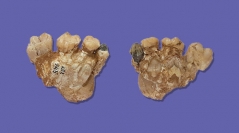

 Comptes Rendus Palevol
22 (33) - Pages 667-688
Comptes Rendus Palevol
22 (33) - Pages 667-688The hominoid Ouranopithecus macedoniensis (Bonis, Bouvrain, Geraads & Melentis, 1974) is known from three Late Miocene localities in Greece. All are correlated with late Vallesian, MN10; more precisely, they are dated between 9.6 and 8.7 Ma. During the last 50 years several fossils of this hominoid have been recovered. The present article describes the first specimen with upper deciduous teeth, recovered from the locality Ravin de la Pluie in Axios Valley (Macedonia, Greece). The upper deciduous dentition of O. macedoniensis is characterised by a small canine relative to the length of the deciduous premolars, with a rounded occlusal crown outline, a trapezoidal dP3 with metacone and a rudimentary hypocone, a sub-squared dP4, and the absence of cingulum. The taxonomic and sexual attribution of the studied material is based on the preserved and virtually reconstructed permanent dentition, using high resolution microcomputed tomography. The morphological and metrical comparisons of the permanent dentition with the available sample of O. macedoniensis, as well as the monospecific character and the strong sexual dimorphism of the Ravin de la Pluie sample, allow its attribution to a female sub-adult individual of this taxon. The upper deciduous teeth of Ouranopithecus macedoniensis preserve some morphological features, that may have a phylogenetic value, but this hypothesis requires further investigation as the available material of all fossil taxa is poor.
Hominoids, deciduous, description, comparisons, μCT scan, Greece